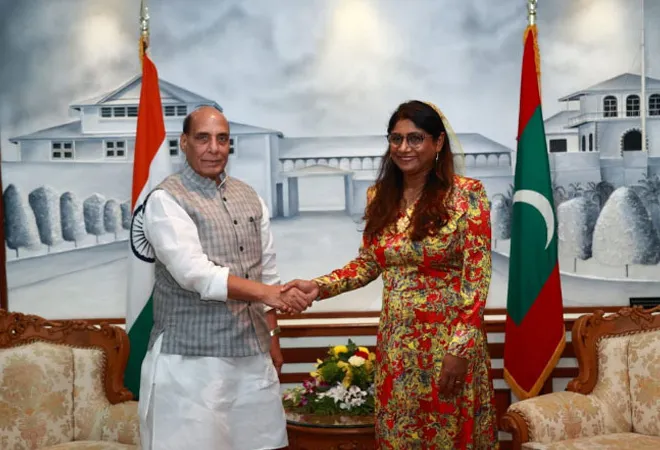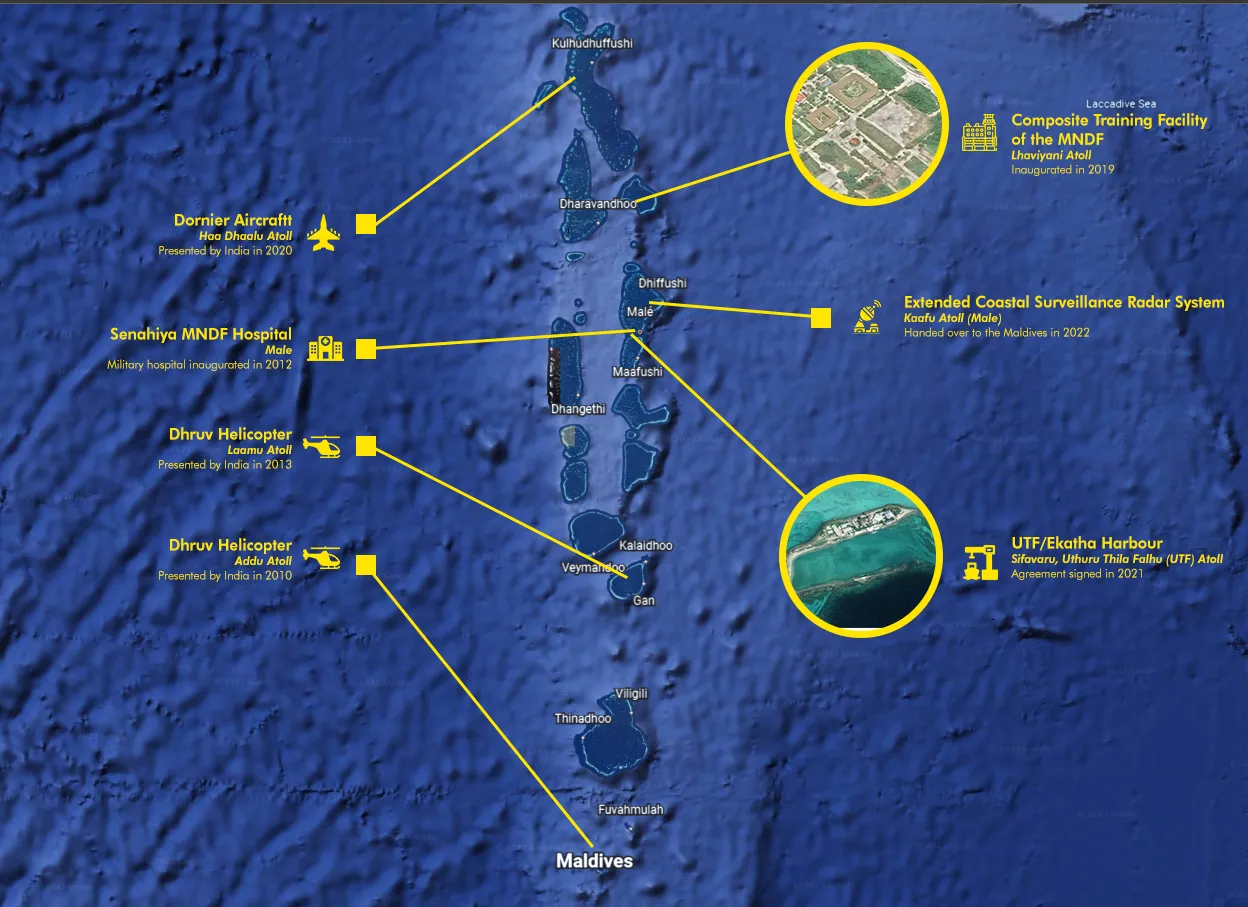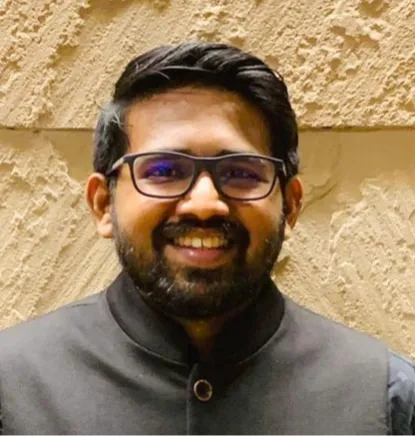
India’s Defence Minister, Rajnath Singh, was on a three-day visit to the Maldives earlier this month. During the visit, the Minister discussed the entire gamut of defence relations, handed over a Fast Patrol vessel and a Landing Craft Assault ship to the Maldives National Defence Force (MNDF), and laid the foundation stone for constructing the Ekatha Harbour at Uthuru Thila Falhu (UTF). This timely visit indicates India and Maldives’ increasing defence cooperation in the region. As Maldives heads to Presidential elections this year, a lot is at stake for this defence cooperation. Its fate will depend on India’s and the Maldives’ capability to return to a non-partisan defence partnership, domestic politics in the Maldives, and China’s desire to enhance the defence partnership with the Maldives.
< style="color: #163449;">An overview of defence cooperation
The defence cooperation between India and the Maldives has increased since 1988 and has only expanded with subsequent Maldivian governments. The Maldives remains aware of its geographical vulnerabilities and lack of capabilities to safeguard its Exclusive Economic Zones (EEZs). It has continued to look upon its largest neighbour, India, to assist with the same. On the other hand, India uses this cooperation and assistance to reinforce its influence as a regional power and net security provider. It also provides an opportunity for India to keep a check on China’s increasing activities in the Indian Ocean and also mitigate transnational threats such as extremism, illegal fishing, and drugs and arms trafficking.
< style="color: #0069a6;">The Maldives remains aware of its geographical vulnerabilities and lack of capabilities to safeguard its Exclusive Economic Zones (EEZs).
India’s assistance to the Maldives intends to contribute to MNDF’s capacity-building and enhancement. For this, it has embraced a multi-faceted approach such as assisting with defence infrastructure and radars (Table 1); supplying military hardware and equipment (Table 2); organising institutionalised high-level engagements and joint-exercises (Table 3); joint patrolling and surveillance of Maldives’ EEZ; information sharing, exchange programmes; frequent ship visits, and medical training and assistance to MNDF personnel. New Delhi also offers assistance with humanitarian and disaster response, search and rescue operations, hydrographic mapping, and maritime domain awareness. Both militaries also cooperate in platforms like the Indian Ocean Naval Symposium, Indian Ocean Rim Association, and Goa Maritime Conclave. In addition, India has trained pilots, observers, and engineers to operate the gifted aircraft. It has also stationed around 75 unarmed troops in the Maldives to assist the MNDF in maintaining and operating these aircraft. The number of troops is expected to increase upon the UTF’s completion. Overall, India provides the largest training opportunities for the MNDF cadres, meeting around 70 percent of their requirements. From 2021-2022, India offered 300 training vacancies to the MNDF. In the past 10 years alone, India has trained over 1,400 MNDF personnel—an impressive streak for a military force of 4,000 personnel only.
Table 1. India’s assistance with defence infrastructure
| Infrastructure |
Nature of Assistance |
Year |
| Senahiya MNDF military Hospital |
India helped transform this facility into a hospital. It has assured that medical staff from Indian military (estimated six individuals) will be based in the hospital. India also frequently supplies medical equipment to this hospital. |
Inaugurated in 2012 |
| Composite Training Facility of the MNDF |
This will serve as the main training centre for the MNDF. India has offered a grant of US$1 million to assist with the Centre’s administrative building, basic infrastructure, accommodation, and training facilities. |
Inaugurated in June 2019 |
| Extended Coastal Surveillance Radar System (CSRS) |
From 2007, India has installed 10 coastal surveillance radars across the country and a CSRS to integrate the information from these radars. The CSRS data will also feed into India’s International Fusion Centre. This helps the MNDF with maritime surveillance. |
Handed over in 2022 |
| Ekatha Harbour (UTF) |
UTF is India’s biggest grant-in-aid project in the Maldives. India will help develop and maintain the harbour and also provide professional, technical and logistical support for 15 years upon completion. This enables MNDF to dock, maintain, and repair its coast guard vessels. Previously, MNDF approached other countries for vessel repairs. |
The foundation stone was laid in May 2023 |
| Ministry of Defence Headquarters |
Construction of Maldives’ new Ministry of Defence Headquarters |
NA |
Source: Author’s compilation
Table 2. India’s Assistance with Defence equipment
| Defence equipment |
Quantity |
Year |
| Armoured Combat Vehicles |
4 |
1992 |
| CGS Huravee (refitted 6 times by India) |
1 |
April 2006 |
| Dhruv Helicopter |
1 |
April 2010 |
| Dhruv Helicopter |
1 |
December 2013 |
| CGS Kaamiyaabu (Fast Interceptor Boat) |
1 |
December 2019 |
| Dornier Aircraft |
1 |
September 2020 |
| Utility Vehicles |
24 (not delivered yet) |
August 2022 |
| Sea Ambulances |
2 |
January 2023 |
| Landing Craft Assault Ship |
1 |
May 2023 |
| Fast Patrol Vessel (to gradually replace an ageing Huravee) |
1 |
May 2023 |
Source: Author’s compilation
Table 3. Institutionalised engagements and joint-exercises
| Exercise/ Collaboration |
Description |
Latest edition |
| Exercise Ekuverin |
Bilateral exercises between the Indian army and the MNDF. |
2021 (11th edition since 2009) |
| Exercise Dosti |
Trilateral Exercises between the Coast Guards of India, Sri Lanka, and Maldives. |
2021 (15th edition since 1991; Sri Lanka joined since 2012) |
| Exercise Ekatha |
Exercises between the Indian Navy and Marine Corps of the MNDF. |
2022 (5th edition since 2017) |
| Exercise Shield |
Trilateral exercises for anti-Narcotics and maritime search and rescue operations, between the MNDF and the Navies of India and Sri Lanka. |
2021 (1st edition) |
| Mobile Training Team (MTT) |
Ten-member Indian Marine Commando MMT that is ready to be deployed in the Maldives based on MNDF’s requirements and needs. |
2021 (4th edition from 2017) |
| Navy Staff Talks |
Talks on maritime cooperation and bilateral issues. |
2016 (1st edition) |
| Defence Cooperation Dialogue |
Talks on wide agenda of defence cooperation. |
2023 (4th edition from 2016) |
| Joint Staff Talks |
Annual discussions on defence cooperation with all the three Indian military services. |
2022 (6th edition from 2016) |
| Joint Hydrographic Survey |
Hydrographic surveys to identify the seabed, and improve mapping of Maldives’ EEZ and coastal waters. |
2023 (3rd edition from 2021) |
Source: Author’s compilation
< style="color: #163449;">The partisanship-partnership problem:
India’s defence equipment and infrastructure are spread throughout the Maldives (Map 1) and have assisted the MNDF in securing the coasts, guarding the EEZ, and strengthening their capabilities. As a result, the defence partnership with India was perceived as a win-win cooperation across all party lines in the Maldives. That remained the case at least till late 2017. Till this time, subsequent Maldivian Presidents continued to implement Indian projects finalised by previous regimes and also initiated new engagements with India. This is despite their politicising of these projects and criticising the government when in the Opposition. For instance, during Nasheed’s (2008-2012) regime, India and Maldives signed a defence pact in 2009. The pact finalised on India’s assistance to the Maldives, such as a military hospital, radars, and Dhruv helicopters. And India inaugurated the military hospital and delivered the second helicopter to the Maldives only during Waheed's regime (2012-2013).  Map 1.
Map 1.
India’s defence infrastructure and equipment assistance to the Maldives Even during Yameen’s regime (2013-2018), infrastructure building for the second phase of the coastal radar system continued. India and the Maldives also signed a Comprehensive Action Plan for Defence in 2016. Yameen’s presidency also saw the institutionalisation of exercise Ekatha, Navy Staff Talks, Defence Cooperation Dialogue, Joint Staff Talks, and Mobile Training Teams. He had also requested India for UTF harbour and a Dornier aircraft. Despite his de-facto pro-China policy, he continued with the defence partnership with India. However, as investments and cooperation from China increased, Yameen attempted to exercise his agency. He cemented his relations with Beijing, even at the cost of Indian interests.
< style="color: #0069a6;">India and the Maldives also signed a Comprehensive Action Plan for Defence in 2016.
India’s criticism of Yameen’s emergency declaration in 2018 only worsened this equation. He used China to push back against India’s possible intervention, attempted to establish a Chinese Observation Station in the Maldives, and also discussed the possibilities of joint patrols of the Maldivian EEZ with Pakistan. Following it, Yameen also asked India to withdraw its helicopters and personnel from the Maldives. These demands were triggered by China’s reservations against India’s presence and influence in the island nation. But China had also not shown any significant interest in building a defence partnership with the Maldives. As a result, Yameen never put a stop to the India-Maldives defence partnership. While Indian projects were slowing down, Yameen continued to keep defence partnership low-key and to the bare minimum. The Joint Staff talks, Exercise Ekatha, EEZ surveillance, and training from Indian MTT continued even during these tested times.
< style="color: #163449;">A way ahead?
But with Yameen in Opposition since 2018, India’s defence partnership and assistance have been politicised more than at any other time in the past. Yameen and his loyalists launched the “India Out campaign” and have criticised India and President Solih for breaching Maldives’ sovereignty through this defence partnership. Both parties are being criticised for expediting the surveillance radar installments, signing MoUs for Dornier aircraft, UTF harbour, and hydrographic surveys. This is despite Yameen having played a significant role in the initial phases of the projects. In fact, Rajnath Singh’s recent visit to the Maldives was also linked to the Chagos dispute and the deployment of Indian troops in the country. As the Maldives heads to elections in September, its polity continues to witness some unpredictable winds of change. Qasim Ibrahim, who has maintained a neutral stance during the India Out campaign is running for the next presidency. Yameen’s eligibility to contest in the upcoming elections is yet to be clear. And factionalism within the ruling MDP has intensified, with Nasheed now interacting with Yameen’s party and partners regularly. Overall, there seems to be a lack of clarity on the political leaders and alliances and their stance on India’s partnership.
< style="color: #0069a6;">Yameen and his loyalists launched the “India Out campaign” and have criticised India and President Solih for breaching Maldives’ sovereignty through this defence partnership.
As the Maldives witnesses increasing challenges of drug trafficking and illegal fishing, India continues to be its strongest defence partner. However, the future of the cooperation will largely depend on India and the Maldives’ capability to revert this cooperation to non-partisan levels. A change in guard within Yameen’s party might offer new opportunities for New Delhi, but a lot will also depend on the domestic politics in the country, and China’s desire to act as an alternative to India by enhancing defence partnership with the Maldives.
The author would like to thank intern Harris Amjad for his assistance with mapping Indian projects in the Maldives.
Aditya Gowdara Shivamurthy is a Junior Fellow with the Strategic Studies Programme at the Observer Research Foundation
The views expressed above belong to the author(s). ORF research and analyses now available on Telegram! Click here to access our curated content — blogs, longforms and interviews.





 PREV
PREV


